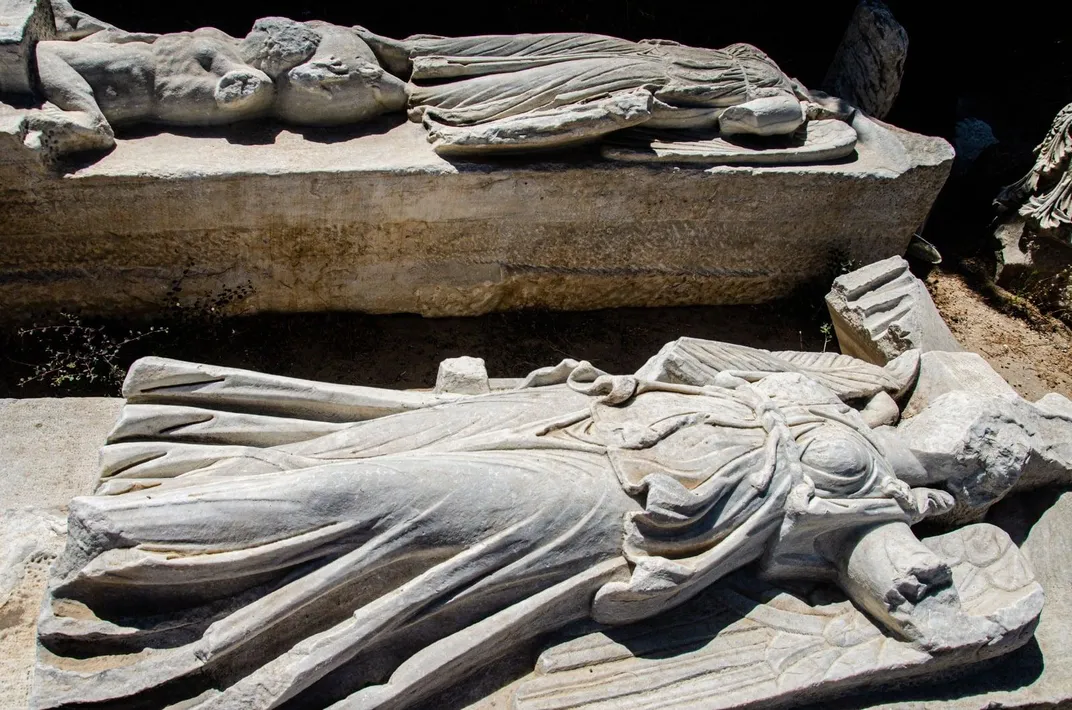Enormous Roman Basilica Dated to King Herod’s Reign Revealed in Israel
At its height, the public building boasted opulent marble columns and sculptures
:focal(551x681:552x682)/https://tf-cmsv2-smithsonianmag-media.s3.amazonaws.com/filer/dd/3c/dd3c6b4e-d3ec-4873-927f-120b853cd796/193311907_639057214158428_3999102054767687332_n.jpeg)
Archaeologists in Ashkelon, Israel, have revealed the country’s largest Roman-era basilica, or public building. Constructed during the first century B.C., the monumental structure dates to the reign of Herod the Great, a Judean king immortalized in the Bible as a murderous tyrant. (The BBC and Live Science note that most historians believe the infamous tale of his so-called massacre of the innocents is fictional.)
Rossella Tercatin of the Jerusalem Post reports that researchers from the Israel Antiquities Authority (IAA) excavated the 2,000-year-old basilica while conducting renovations at Tel Ashkelon National Park. Per a statement, the project seeks to restore the building to its former glory, allowing the public to roam three imposing halls lined with opulent marble columns and sculptures.
This isn’t the first time that scholars have unearthed the basilica’s remains: As excavation leader Rachel Bar-Natan tells the Post, British archaeologist John Garstang, who led an expedition on behalf of the Palestinian Exploration Fund in the 1920s, initially discovered the structure but decided to cover it up again.
Archaeologists returned to the area in 2008, when the first of two recent excavations began. After the second dig concluded in 2018, the Israel Nature and Parks Authority (INPA) partnered with the IAA, the city of Ashkelon and the Leon Levy Foundation to reconstruct the historic site, which is also home to an odeon, or small theater.
“Garstang had already calculated the dimensions of the building,” Bar-Natan tells the Post. “And seeing the remains of the marble columns, made with materials imported from Asia Minor, he had suggested that the basilica dated back to the time of [Herod], since historian Josephus described how the king built a colonnaded hall and other structures in the city.”
According to Haaretz’s Ruth Schuster, coins discovered in the basilica’s foundations pinpoint its construction to Herod’s reign, which spanned 37 to 4 B.C. The edifice measured roughly 360 feet long and 130 feet wide, with a colonnade, or row of columns, standing some 40 feet tall. Like other pre-Christian basilicas in the Greco-Roman world, it served as a civic rather than religious center and consisted of three parts: a central space and two side halls.
Interestingly, the researchers found that the basilica’s marble architectural features date to the late second century A.D., when the Severan dynasty ruled the Roman Empire. Per the statement, marble columns and capitals engraved with depictions of plants and the Roman eagle once flanked the building’s halls; towering statues of victory goddess Nike, condemned Titan Atlas and Egyptian deity Isis-Tyche, among other figures, lined its walls. In total, scholars have recovered nearly 200 objects crafted out of marble imported from Asia Minor.
“You can see in your mind’s eye ships laden with marble, sailing to Ashkelon,” IAA archaeologist Saar Ganor tells Haaretz.
In 363 A.D., a powerful earthquake along the Dead Sea fault inflicted heavy damage on the basilica, which was subsequently abandoned. A few centuries later, under the Abbasid (750–1258 A.D.) and Fatimid (909–1171 A.D.) caliphates, inhabitants of the area repurposed some of the building’s marble as part of new construction projects.
Officials hope that visitors will soon be able to experience the basilica in its pre-earthquake glory. Planned renovations include placing restored columns around the basilica and filling in the structure’s dilapidated floor.
“The Ashkelon National Park is one of the most important ancient sites, both in Israel and in the world, and time and time again it emerges as one of the most visited sites in the country,” says Ashkelon Mayor Tomer Glam in the statement. “… I am convinced that the restoration and conservation work in the park, the new archaeological discoveries, and the development work—including new accessible paths—will contribute significantly to the park’s natural beauty.”
Editor's Note, June 9, 2021: This article has been updated with additional information on the biblical King Herod.
/https://tf-cmsv2-smithsonianmag-media.s3.amazonaws.com/accounts/headshot/Isis_Davis-Marks_thumbnail.png)

/https://tf-cmsv2-smithsonianmag-media.s3.amazonaws.com/filer/5e/02/5e021cef-6bd1-4755-9ae0-faaca72d2db0/193288207_639057354158414_3229928472667825485_n.jpeg)
/https://tf-cmsv2-smithsonianmag-media.s3.amazonaws.com/filer/19/52/1952bfad-1c05-4d92-b56c-ddd557abca4f/193076729_639057347491748_3101465285783809330_n.jpeg)
/https://tf-cmsv2-smithsonianmag-media.s3.amazonaws.com/accounts/headshot/Isis_Davis-Marks_thumbnail.png)